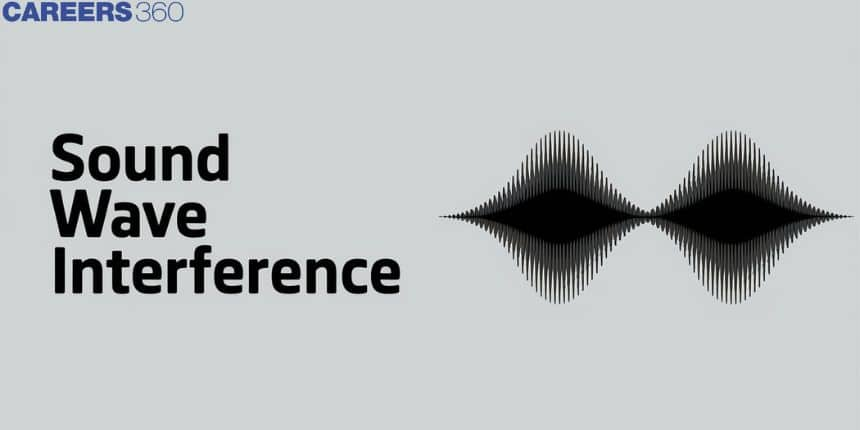Sound Wave Interference
Sound wave interference is a fascinating phenomenon that occurs when two or more sound waves meet and combine. This interaction can lead to a variety of effects, such as the amplification of sound (constructive interference) or the cancellation of sound (destructive interference). In real life, we encounter sound wave interference in various situations, from the way our voices echo in a large room to the design of concert halls that enhance sound quality. Another common example is noise-cancelling headphones, which use destructive interference to block out unwanted ambient sounds. Understanding sound wave interference not only helps in grasping fundamental physics concepts but also in appreciating how these principles are applied to enhance our everyday experiences. In this article, we will cover the concept of Sound Wave Interference this concept falls under the broader category of Oscillations and Waves.
JEE Main/NEET 2027: Physics Important Formulas for Class 10
NEET 2025: Mock Test Series | Syllabus | High Scoring Topics | PYQs
JEE Main: Study Materials | High Scoring Topics | Preparation Guide
JEE Main: Syllabus | Sample Papers | Mock Tests | PYQs

Interference of Sound Waves
We have studied the principle of superposition, this principle of superposition is valid for sound waves also. If two or more waves pass through the same region of a medium, the resultant disturbance is equal to the sum of the disturbances produced by individual waves. Based on the phase difference, the waves can interfere constructively or destructively leading to a corresponding increase or decrease in the resultant intensity. Here the waves are expressed in terms of pressure change. The resultant change in pressure is the algebraic sum of the changes in pressure due to the individual waves. So, there is no need for displacement vectors so as to obtain the resultant displacement wave.
Let us take two tuning forks S1 and S2 placed side by side. which vibrate with equal frequency and equal magnitude. The point P is situated at a distance x from S1 and

The forks may be set into vibration with a phase difference
where
Here,
The resultant amplitude is maximum when
The above equation is obtained with the help of the (1) equation.
At constructive interference,
At destructive interfernece
| Constructive interference | Destructive interference |
| 1. When the waves meet with the same phase, they form constructive interference | 1. When the waves meet with opposite phases, they form destructive interference |
2. Phase difference at the point of observation. | 2. Here, phase difference |
| 3. Path difference | 3. Path difference |
| 4. Resultant amplitude | 4. Resultant amplitude = |
| 5. Resultant intensity will be maximum | 5. Resultant intensity will be minimum |
Recommended Topic Video
Solved Examples Based on Sound Wave Interference
Example 1: If two sound waves of amplitudes 3 and 5 units interfere with each other. Then find the ratio of maximum to minimum intensity in the resultant wave.
1) 2:1
2) 5:3
3) 4:1
4) 16:1
Solution:
The ratio of maximum to minimum intensity is given by
Hence, the answer is the option (3).
Example 2: Which of the following statements are true about the interference of sound waves?
1)When the waves meet with the same phase, they form constructive interference.
2)When the waves meet with opposite phases, they form destructive interference.
3) both 1 and 2
4)None of the above
Solution:
- When the waves meet with the same phase, they form constructive interference.
- When the waves meet with opposite phases, they form destructive interference.
Hence, the answer is the option (3).
Example 3: Two sound waves travel in the same direction in a medium. The amplitude of each wave is A and the phase difference between the two waves is
1) 2A
2) 3A
3) 4A
4) A
Solution:
Resultant Intensity
wherein
Here
The amplitude of the resultant wave is
Hence, the answer is the option (4).
Example 4: If the phase difference between two sound waves of wavelength
1)
2)
3)
4)
Solution:
Sound Wave
As sound waves travel through the air, the element of air vibrates to produce a change in density and pressure along the direction of motion of the wave.
wherein
sound waves travel through any material medium with a speed that depends on the properties of the medium.
Path difference for a given phase difference is given by
Hence, the answer is the option (1).
Example 5: A car sounding its horn at 480 Hz moves towards a high wall at a speed of 20 m/s, the frequency of the reflected sound hard by the man sitting in the car will be nearest to (take the speed of sound =330 m/s)
1) 480 Hz
2) 510 Hz
3) 542 Hz
4) 570 Hz
Solution:

Hence, the answer is the option (3).
Summary:
Sound wave interference is a crucial concept in physics, where the superposition of sound waves can lead to either constructive or destructive interference, affecting the resultant intensity. This principle is evident in various real-life applications, such as noise-cancelling headphones and acoustic engineering. By understanding the conditions for different types of interference, one can predict and manipulate sound behaviour in diverse scenarios.
Also Read
17 Nov'24 10:26 AM
17 Nov'24 10:24 AM
17 Nov'24 10:21 AM
17 Nov'24 10:18 AM
17 Nov'24 10:16 AM
17 Nov'24 10:15 AM
26 Sep'24 11:43 AM
25 Sep'24 05:36 PM
25 Sep'24 05:35 PM
25 Sep'24 05:34 PM